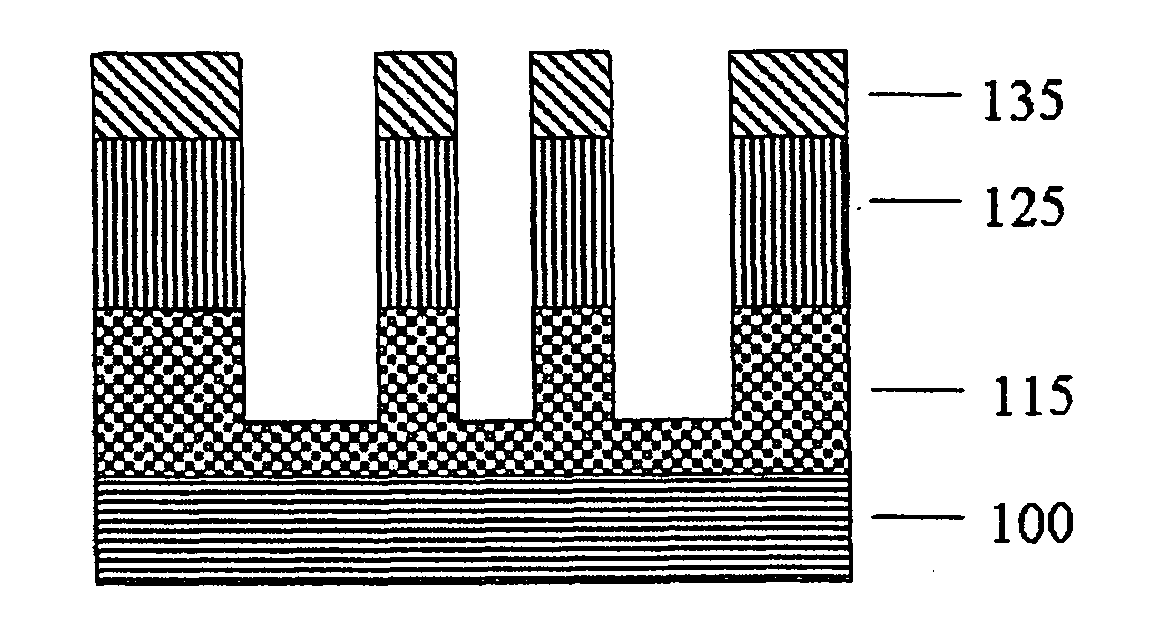Polymer having antireflective properties and high carbon content, hardmask composition including the same, and process for forming a patterned material layer
a technology of anti-reflective properties and high carbon content, applied in the direction of photosensitive materials, instruments, photomechanical equipment, etc., can solve the problems of poor etch selectivity of imaging layers and consumption of imaging layers during etching of target material layers, and achieve high carbon content
- Summary
- Abstract
- Description
- Claims
- Application Information
AI Technical Summary
Benefits of technology
Problems solved by technology
Method used
Image
Examples
synthesis example 1
Synthesis of polymer of 4,4′-(9-fluorenylidene)divinylphenol and 1,4-bis(methoxymethyl)benzene, and reaction of the polymer with allyl chloride
[0056]445.58 g of 4,4′-(9-fluorenylidene)divinylphenol, 3.08 g of diethyl sulfate and 350 g of propylene glycol monomethyl ether were completely dissolved with stirring in a 3 L three-neck flask, equipped with a mechanical agitator and a condenser, while maintaining the temperature of the reactor at 130° C. 10 minutes after the dissolution, 116.35 g of 1,4-bis(methoxymethyl)benzene was added dropwise to the solution, and then the resulting mixture was allowed to react at the same temperature for 15 hours. 2.98 g of triethanolamine was then added as a neutralizing agent to quench the reaction. After completion of the reaction, acid was removed from the reaction using a mixture of water and methanol, and low-molecular weight compounds, e.g., oligomers and monomers, were removed using methanol to yield a polymer represented by Formula 5 (Mw=10,0...
synthesis example 2
Synthesis of polymer of 1-naphthol and paraformaldehyde, and reaction of the polymer with allyl chloride
[0058]The procedure of Synthesis Example 1 was repeated, except that 144.17 g of 1-naphthol and 30.03 g of paraformaldehyde were used instead of 445.58 g of 4,4′-(9-fluorenylidene)divinylphenol and 166.22 g of 1,4-bis(methoxymethyl)benzene, to yield the polymer of Formula 7.
[0059]The molecular weight and the polydispersity of the polymer were measured by gel permeation chromatography (GPC) in tetrahydrofuran, and were determined to be Mw=10,000, n+m=20, and polydispersity=2.2.
synthesis example 3
Synthesis of polymer of 1-pyrenol and paraformaldehyde, and reaction of the polymer with allyl chloride
[0060]The procedure of Synthesis Example 1 was repeated, except that 218.25 g of 1-pyrenol and 30.03 g of paraformaldehyde were used instead of 445.58 g of 4,4′-(9-fluorenylidene)divinylphenol and 166.22 g of 1,4-bis(methoxymethyl)benzene, to yield the polymer of Formula 8.
[0061]The molecular weight and the polydispersity of the polymer were measured by gel permeation chromatography (GPC) in tetrahydrofuran, and were determined to be Mw=12,000, n+m=20, and polydispersity=2.3.
PUM
| Property | Measurement | Unit |
|---|---|---|
| Fraction | aaaaa | aaaaa |
| Fraction | aaaaa | aaaaa |
| Fraction | aaaaa | aaaaa |
Abstract
Description
Claims
Application Information
 Login to View More
Login to View More - R&D
- Intellectual Property
- Life Sciences
- Materials
- Tech Scout
- Unparalleled Data Quality
- Higher Quality Content
- 60% Fewer Hallucinations
Browse by: Latest US Patents, China's latest patents, Technical Efficacy Thesaurus, Application Domain, Technology Topic, Popular Technical Reports.
© 2025 PatSnap. All rights reserved.Legal|Privacy policy|Modern Slavery Act Transparency Statement|Sitemap|About US| Contact US: help@patsnap.com



